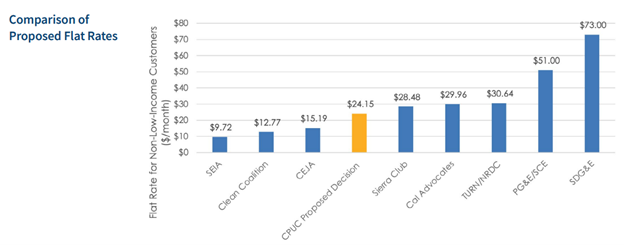
On March 27, the California Public Utilities Commission (CPUC) released a Proposed Decision that would change how residential customers pay for electricity delivered by the state’s large investor-owned utilities. E3 provided technical support to the CPUC and developed a publicly available, impartial rate design tool that is cited extensively in the Proposed Decision.
Today, most residential customers in California are on a fully volumetric rate (c/kWh), meaning their entire electric bill is assessed based on their monthly electricity usage. This makes California an outlier, as the large majority of US electric customers pay a bill with both fixed and volumetric components.
Assembly Bill 205 (2022) required the CPUC to establish an income-graduated fixed charge in residential rates, aiming to reduce bills for low-income ratepayers and to improve the cost-effectiveness of electrification. This legislation led the CPUC to open a new track in a public proceeding focused on developing an income-graduated fixed charge. Over the past year, stakeholders have submitted different proposals, debated the merits and disadvantages of the proposals, and discussed considerations regarding the feasibility and legality of different implementation options.
The new Proposed Decision would simultaneously reduce the volumetric cost of electricity and implement a fixed charge of $24/month, with reduced charges of $12/month for customers in the Family Electric Rate Assistance program (FERA) and customers living in certain kinds of affordable housing, and $6/month for the ~30% of customers enrolled in the California Alternate Rates for Energy bill discount program (“CARE.”) This change would enable a reduction in the volumetric usage rate of 5 to 7 c/kWh, which would help customers see greater bill savings from adopting electric vehicles and electric building equipment. If approved, these changes will be implemented in late 2025 or early 2026.
E3 supported this Proposed Decision by developing a Microsoft Excel-based “Fixed Charge Design Tool,” which the CPUC refers to as the “Public Tool.” This model supported multiple objectives throughout the proceeding:
- The E3 “Public Tool” includes a robust breakdown of the residential revenue requirement into granular cost categories based on data requests to the investor-owned utilities. This enabled stakeholders and decisionmakers to understand the underlying costs reflected in residential rates.
- The E3 Public Tool enabled stakeholders to design revenue-neutral rates that include an income-graduated fixed charge. By varying input parameters, stakeholders could design novel fixed charge proposals with the model determining the appropriate reduction in volumetric rates to maintain revenue neutrality.
- The E3 Public Tool provided a template for stakeholders to file their proposals in testimony, enabling comparison among stakeholder proposals on an apples-to-apples basis. Seven parties ultimately filed proposals using the model, and multiple stakeholders used the model to compare party proposals in their reply testimony.
- The E3 Public Tool enabled the Commission to assess the potential outcomes of the Proposed Decision, including estimated bill impacts for customers in different parts of the state, as well as the impacts on customer bill savings from electrification.

The Proposed Decision is available here. A fact sheet on the Proposed Decision is available here. E3’s Fixed Charge Design Tool (“Public Tool”) is available here.
The E3 team developing and supporting the E3 Public Tool includes Hannah Platter, Tara Hamilton, Margo Bonner, Ari Gold-Parker, and Snuller Price.


